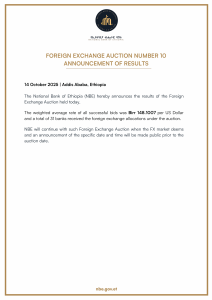29 July 2025 | Addis Ababa, Ethiopia
Today marks the one-year anniversary of Ethiopia’s historic package of macroeconomic reforms and, in particular, of NBE’s transformative changes to its monetary, external, and financial sector policies. These reform measures, launched after a period of extensive preparations on July 29, 2024, opened a new chapter in the implementation of Ethiopia’s Home-Grown economic reform agenda and showed a bold commitment to establishing a stable macroeconomic foundation that can sustainably support Ethiopia’s ambitions of rapid, inclusive, and job-creating growth. On the occasion of the one-year anniversary, NBE would like to share the major milestones reached so far, the many early successes registered to date, and the still remaining work ahead.
A Comprehensive Package of Reforms
NBE’s policy initiatives over the past year have covered a very wide-ranging set of monetary, external, and financial sector measures. A major overhaul of decades-old policies and practices has been put in place. Most notably:
- Monetary policy has been modernized and aligned with global best practices:
– Inflation control has been prioritized as NBE’s primary institutional objective.
– A Monetary Policy Committee (MPC) has been established to regularly monitor macroeconomic developments, prepare forecasts, and independently advise on needed policy responses; a quarterly release of MPC Statements was also initiated.
– A central bank policy rate (NBR) has been introduced to signal the stance of monetary policy and to help manage liquidity and credit conditions in the economy.
– Mandatory requirements that banks purchase Treasury bonds were repealed.
– Open Market Operations were launched as a market-based monetary policy instrument to help the central bank calibrate banking sector liquidity conditions.
– Standing Deposit and Standing Lending facilities were created, enabling banks to place funds at or borrow from the central bank based on their liquidity conditions.
– An Emergency Liquidity Assistance facility was created to aid banks in financial stress.
– An electronic inter-bank money market was set up to allow banks to borrow from and lend to each other—without NBE involvement—for liquidity management purposes. - The exchange rate policy regime has been fundamentally liberalized to unleash the economy’s fx-generating potential and to restore external and debt sustainability:
- A market-based determination of the exchange rate has been introduced.
- FX surrender requirements previously imposed on banks have been removed, while most current account restrictions have been removed or substantially eased.
- Exporter friendly reforms were put in place, including the right to hold on to a higher share of their fx earnings and for a longer period of time.
- New fx markets were introduced, including fx bureaus and inter-bank fx dealing.
- External borrowing for Ethiopian banks and businesses was substantially eased.
- Foreign portfolio inflows were allowed into the domestic capital market.
- Financial sector policies have been revamped to usher in a more competitive, inclusive, and increasingly digitized financial system:
- A New NBE Proclamation has established a relatively autonomous central bank while also introducing new norms for governance, operations, and transparency.
- A New Banking Sector Proclamation has modernized banking sector practices as well as the NBE’s regulatory and supervisory approaches and tools.
- Several new banking directives have improved banking practices with respect to credit appraisal, related party lending, single borrower exposures, and governance.
- The banking sector was finally opened to allow for the entry of foreign banks.
- The sector’s largest and most systemic bank was recapitalized and strengthened.
- Financial inclusion and digitization initiatives were significantly advanced.
Positive Results and Momentum
Our reforms are delivering impressive results, and even while there remains much more to be done:
- Monetary policy reforms have brought tangible gains in multiple areas:
o Lower inflation is helping moderate Ethiopia’s cost-of-living burden, with the rate of price increases lowered to 13.9% as of June 2025 vs 20% a year ago.
o Positive real interest rates have been established in key markets (including in the inter-bank money market and T-Bills market) aided in part by the central bank’s new policy rate and substantially improving incentives for savings in Birr assets.
o Direct central bank credit to Government was eliminated for the first time in 12 years, supporting the central bank’s monetary stance and efforts to reduce inflation.
o New electronic-based money markets are helping banks manage their short-term liquidity without the need for central bank intervention, with over Birr 850bn in inter-bank lending executed as of end-June 2025. - Exchange rate reforms have substantially boosted fx inflows, improved fx availability for businesses, and significantly strengthened Ethiopia’s balance of payments position:
- Overall fx inflows in Ethiopia grew by 33 percent in this first year of reform, reaching a record $32bn and comprised of $8.3bn in goods exports, $8.5bn in service exports, $7.1bn in private transfers/remittances, $1.9bn in official grants, $2.7bn in new loans (excluding IMF), $3.9bn in FDI, and $0.2bn in non-FDI private capital inflows.
- This increased volume of fx inflows has allowed for—and been channeled into—close to $19bn of goods imports, $6.7bn of service imports, and $1.4 bn of debt service payments; in addition, it has enabled a three-fold increase in FX reserves at NBE and a two-fold increase in fx assets at commercial banks.
- For the private sector, FX reform has brought a doubling of FX supply to businesses, as banks’ average daily fx sales to businesses now averages $25mn per day vs $11mn per day at the start of reform, while fx sales to businesses are averaging $500mn per month vs $258mn per month a year ago.
- Thanks to the more favorable policies of the new FX Directive, around $445mn in new foreign borrowing and suppliers’ credits has been secured by the private sector this past year, more than double the $204mn secured the previous year.
- Close to ten new fx bureaus have been established and are addressing on demand the cash needs of personal and business travelers.
- Financial sector developments have been marked by strong and stable growth, by product innovation, and by widespread digitization:
- The pool of financial sector deposits has grown by 41% and now stands at 3.5 trillion.
- Domestic credit has expanded by 22% and reached Birr 3.4 trillion.
- Stability indicators have continued to remain within regulatory limits, including for the NPL ratio (3.9%), capital adequacy ratio (17.3%), and liquidity ratio (24.9%).
- Impressive growth continues to be registered across all key inclusion and digitization metrics, including for the number of transaction accounts, access points, credit accounts and SME credit; similarly strong growth and record levels have been registered for numbers of digital accounts, digital transactions, digital channels, as well as fast-expanding digital savings and credit services.
Further work ahead
While the progress to date is impressive, much more remains to be done. Ethiopia’s monetary, exchange rate, and financial sector policies will need on-going calibration and fine-tuning for many years to come, especially in the context of a fast-growing and rapidly transforming economy. Within NBE’s specific mandate, our work for the year ahead will prioritize:
- Further reducing inflation to single-digit levels, given the critical importance of addressing Ethiopia’s still challenging cost-of-living situation.
– Moving to a fully interest-based monetary policy framework.
– Deepening the foreign exchange market to ensure a unified market with increasing transaction volumes and continuous improvements in fx accessibility for business and individuals.
– Making further efforts to maximize remittance inflows through collaborative arrangements between the central bank, commercial banks, and remittance service providers.
– Facilitating the entry of foreign banks, thus boosting competition, innovation, and accessibility.
– Advancing new initiatives in a number of areas such as insurance, micro-finance, interest-free banking, agricultural finance, and housing finance.
– Intensifying financial sector supervision and oversight, including via enhanced enforcement measures where necessary, in critical areas such as credit administration, fx operations, consumer protection, digital payments/infrastructure, and governance.
– Supporting the capital market functions of the ESX and the Treasury Bill market by strengthening the NBE’s Centralized Securities Depository (CSD) functions, especially work in the dematerialization of public and private securities over the course of 2025-26.
– Finalizing NBE modernization initiatives, including the execution of NBE’s new organizational structure and establishment of a center of excellence for financial training and education.
Conclusion
In concluding, and as we mark the one-year anniversary of NBE’s historic reforms, we would like to extend a special appreciation for all those who have made these initial successes possible. The results registered so far would not have been realized without the active role played by many key pillars of our economy—including our domestic banks, who have adapted swiftly and constructively to major policy shifts, and the business community, which has been instrumental in fx-generating activities such as goods and service exports, remittances, and foreign investment. The financial and technical support of our international partners—the IMF, World Bank and external creditors—has been indispensable and also merits a special recognition.
For the year ahead, our message to the financial sector, to the business community, and to the wider public is to continue in the collaborative spirit of the past year to deliver yet another year of record results. We at NBE are optimistic and indeed confident on the macroeconomic outlook for 2025-26, and anticipate a year of strong growth, declining inflation, balanced credit expansion, and an improving external position marked by rising exports, remittances, capital inflows, and fx availability. Indeed, we expect the overall macroeconomic setting in Ethiopia to be the most favorable that it has been in many years, even as the Government continues to address the wider policy reform agenda involving sectoral, structural, and investment climate issues. In sum, with strong efforts by all stakeholders and continued collaboration across the policymaking, financial, and business communities, maintaining Ethiopia’s much improved macroeconomic standing alongside its strong growth and developmental momentum is not just possible but also well within our reach.


